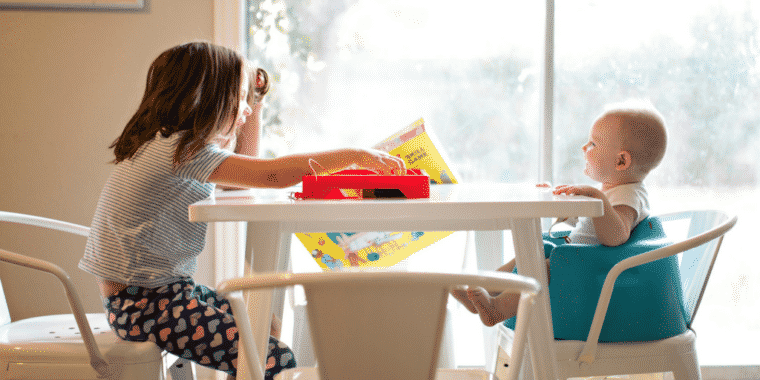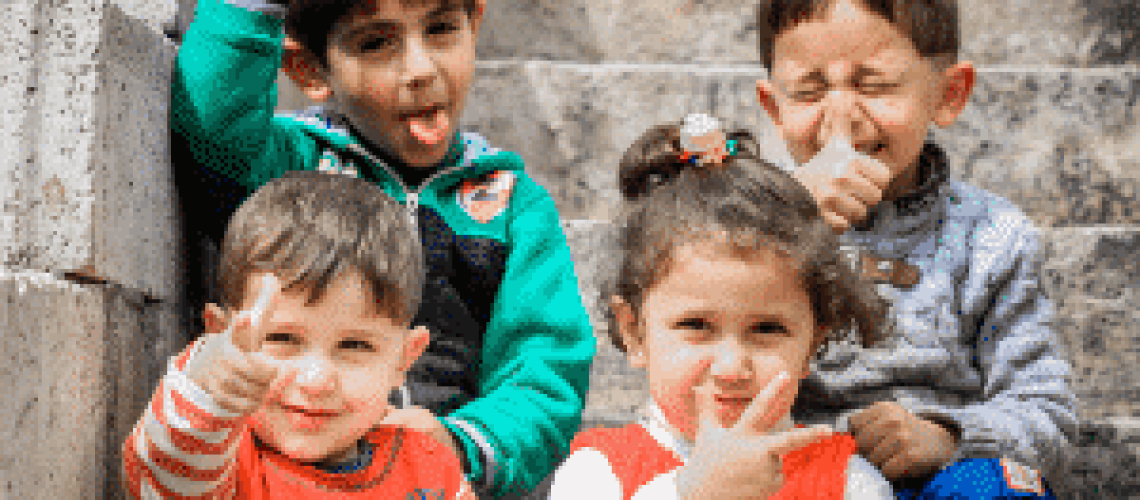
Things were prickly from the get-go that morning. My older daughter, then nine years old, sat on the couch, acting groggy and still waking up. Two feet away, her three-year-old sister was on the floor playing with a pile of miniature plastic figures, and she seemed offended by her big sister’s inattention.
She said to her older sister, in a whining tone, “Quit looking at me!” Big sister responded, “I’m not looking at you!” (She hadn’t been, until that moment.). Of course, the younger one screamed, “You are!” And on and on. Any parent or caregiver of siblings knows how that kind of exchange goes, and how it can quickly escalate into heated conflict.
Not Unusual: Why Sibling Conflicts Happen
It would be nice to say that these sorts of conflicts are rare in our family. They are not. However, their chances of resolving somewhat peacefully or even happily largely depend, I have learned, on whether or not I intervene and how. And intervention is most effective if I remind myself to view the conflict in the same way that I see stuck situations or off-track behavior individually in my kids: as a call-out for connection. You can never go wrong with bringing more connection into the situation, even if the rift seems, at the surface, to be less about you and more about the sibling relationship.
In that morning incident, in which our younger child-targeted the older, my husband and I decided to take action.
We had a little space in our morning, so we suggested doing what we call our “Special Time Rotation.” One child would get five minutes of one-on-one time with me, while the other one would have that same time with her father’s enthusiastic attention, and then we would switch. My younger daughter and I played with her plastic figures, per her direction, and then, when it was my turn to be with my older one, she wanted to cuddle on the comfy living room chair with me and talk.
The Special Time—just ten minutes total—worked to smooth out the prickles in our household that morning; things got back to normal, and we were able to move forward with our start-of-day routines. Even after years of using the tool of Special Time, it amazes me how even a small chunk of this kind of connection infusion can work to clear out the yuck and restore a feeling of harmony in our familial relationships. For us, it detangled the emotional knots between two sisters, who deep down love each other but were having a hard time realizing it first thing that morning.
Healing Hurts, Repairing Disconnection
Sometimes a child’s targeting of her or his sibling is indeed more about feelings of disconnection with a parent, rather than actual ill will toward the sibling. When my older daughter initiates a conflict with her little sister, sometimes I can pause and hear what she is really saying as she ridicules, or refuses to share an item or allow entry into her room. Sometimes, in not these exact words, she might even say it to me: “You don’t like me as much as you like her. Ever since she came into the picture, you don’t pay any attention to me.” That sentiment can get played out in off-track behavior toward or near me, and yes, the negativities related to that sentiment can show up in targeted action at younger sister.
I try to see that big sister is not a bad sister; she is behaving irrationally from a place of hurt and fear.
I still remember how utilizing Hand in Hand tools like Staylistening were invaluable in the early days after little sister’s arrival. From the beginning, I was able to support my older daughter when she had doubts about the new state of affairs; when her feelings erupted, she was showing me her fears about losing her emotional security, about losing love—these things being the foundations of what children need to survive and thrive.
When she showed us those fears, which played out in emotional ripples, off-track behavior, and tantrums, I knew to stay close, and to listen to and support the rough feelings instead of trying to stop them. With support from me, her father, caregivers, and teachers, in those early days of our newly expanded family, she got a chance to air out fears and be heard; she became a caring, loving big sister.
Fast-forward to the present: Has older sister always been thrilled about having a little sister? Of course not.
We do see conflicts between the two siblings (now ages 10 and 4), and sometimes it is the result of one sibling—knowingly or seemingly unconsciously—targeting the other.
When it is big sister acting inflexibly or harshly, I do my best to recall those earlier fears that she showed me five years ago. I try to see that big sister is not a bad sister; she is behaving irrationally from a place of hurt and fear. Like all children, she strives for connection and thrives when that connection is strong and reliable. Fueled by connection, children want to get along with others in their lives, including their siblings.
Five Ideas for Bringing More Harmony Into Sibling Relationships
 When I, as a parent, am focused on strengthening connection in my household, the whole family seems to operate in a smoother, more joyous way. Here are five ideas for nourishing the dynamics for all, including between and among siblings:
When I, as a parent, am focused on strengthening connection in my household, the whole family seems to operate in a smoother, more joyous way. Here are five ideas for nourishing the dynamics for all, including between and among siblings:
1) Regular Special Time for each child
This involves a parent setting a timer (say, for 15 or 20 minutes) and following the child’s lead in an activity of the child’s choice, with their full enthusiastic attention. What happens when children get regular Special Time is that they feel more secure in their connection with you; essentially, they feel safer. And when they feel safer, they act more cooperatively, more flexibly, and that includes their behaviors and actions with their siblings.
Read the chapter on Special Time from our book Listen.
2) Interactive pillow play
Many families utilizing the Hand in Hand approach love family pillow fights. All ages can get involved, and a side note for the adults: Try to let your kids feel powerful in this game, and encourage laughter (without tickling). Also, pillows are versatile! A game that my older daughter invented is called “Queen of the Pillows.” You gather together a pile of pillows, and one person—the “queen” or “king”—sits on top of them, and tries to prevent everyone else from stealing them. Once the royal person has been dethroned (i.e., all pillows stolen), then a new queen or king sits atop the pile.
3) Make space for feelings
When big feelings emerge—anything from angry outbursts to downpours of tears—try to make some space to truly listen to them without judgment. At times, that may mean that you need to find a way for the other child (or children) to stay safe and/or occupied while you listen warmly and lovingly to the child expressing feelings. Giving a child who is offloading their tensions, fears, and/or hurts a chance to be heard will help that child get back to her or his clearer-thinking, more cooperative self. Sometimes, following a conflict, there will be two or more children with feelings to express; at such times, you may need to get creative, or give each child short turns of your supportive listening attention.
4) Set limits early, firmly, and calmly
When aggression occurs, it is up to us as adults to keep children safe, both physically and emotionally. When one child strikes or otherwise hurts another child with hands, feet, and/or words, we need to insert ourselves into the incident. Sometimes you'll use your own body as a shield to prevent a child from being hit or kicked. But just because an incident seems fury-filled does not mean parents need to be charged in reacting. Many times, I have put myself between my girls and prevented physical contact between them, while saying, “I can’t let you hurt your sister.”
Does this mean it stops right there? No, not usually. But I have calmly set a boundary, and then, pushing up against that boundary, one of the children might then unleash her feelings, thus bringing us back up to #3 above, Staylistening. This opens the door to healing the hurts inside—and thus, possibly, the rift between the siblings.
5) Create opportunities for sibling connection
We try to find, as much as possible, family activities that both of our girls will enjoy and that encourage them to engage and interact with each other (and with us, as parents). At home, we have favorite board games, and we have found some fun physical-play activities through Lawrence Cohen’s book The Art of Roughhousing. Outside the house, we spend time in nature, at parks with good scootering and skateboard areas, and—our most recent favorite destination—our local bowling alley. Wherever we are, even when the goal is fun, I know to expect the occasional sticky spots.
Those are times that I am particularly grateful for the Hand in Hand tools that keep my eye on connection.
- What can you do when your children fight and you get there too late
- For ongoing help turn to this Ultimate Sibling Rivalry Guide and learn how the Hand in Hand tools can help you and your children feel closer.
Where do parents go to get the support they need?
The Hand in Hand Parent Club Community. Click to learn how to get your TWO WEEK free trial and start getting solutions for your parenting challenges. If you are already a member of our new Hand in Hand Network click here for your free TWO WEEK free trial.

